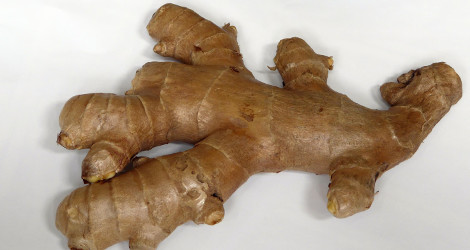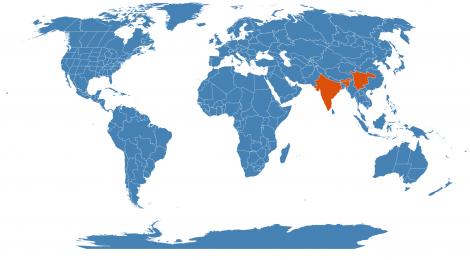Accession Data:
Zingiber officinale Roscoe.
- Common Name: Common Ginger
- Family: Zingiberaceae Lindley
- Description: Leafy stems to 20 inches; leaves to 7 inches long, 3/4 inches wide; inflorescence on a separate stem, a dense spike, to 3 inches long, bracts green with translucent margin; flowers yellow-green, lip purple with cream blotches and base.
Cultivars are sterile but are widely cultivated in tropical and warm temperate lands for the rhizomes, from which ginger is made.
- Uses: Commonly used medicinally against nausea and inflammation.
Ginger used in many distinct traditions have been used to aid in digestion which may include bloating, pain, flatulence, vomiting.
By adding ginger to a paste made of honey and tea tree oil, it can help reduce skin inflammation, acne, rashes, and redness.
Honey and ginger diluted with a little bit of water can be taken internally to help relive respiratory aches, coughing, fever, and asthma. Although honey in some cases is a diuretic and can cause phlegm buildup. This action is necessary in clearing away pathogenic agents from the lungs and riding the body of it.
For women experiencing painful, irregular menstruation, ginger is traditionally take with a cup of boiled water4. For problems with impotency, taking ginger with honey can relieve premature ejaculation, involuntary seminal discharge, and excessive sperm ejaculation.
Modern studies have been conducted in terms of Ginger's antibacterial and antimicrobial properties.
- IMPORTANT NOTE: Plant Uses are for informational purposes only. EEB Greenhouses assume no responsibility for adverse effects from the use of any plants referred to on this site. Always seek advice from a professional before using any plant medicinally.
- Culture: Prefers a winter rest period with reduced water and light.
- USDA Zone: 8b-11
Accession Data:
- Accession # 199700004
- Source: Banana Tree
- Accession Date: 02-03-1997
- Bench: 0 - unassigned location
- Currently: culled
- Qty: 0 confirmed on 10-01-2019
Classification:
- Division: Magnoliophyta
- Class: Liliopsida
- SubClass: commelinids
- Order: Zingiberales
- SubOrder:
- Family: Zingiberaceae
- SubFamily: Zingiberoideae
- Tribe: Zingibereae
- SubTribe:
Flowering Data:
This accession has been observed in bloom on:| Year | Jan | Feb | Mar | Apr | May | Jun | Jul | Aug | Sep | Oct | Nov | Dec | ||||||||||||||||||||||||||||||||||||||||
|---|---|---|---|---|---|---|---|---|---|---|---|---|---|---|---|---|---|---|---|---|---|---|---|---|---|---|---|---|---|---|---|---|---|---|---|---|---|---|---|---|---|---|---|---|---|---|---|---|---|---|---|---|
| 2019 | ||||||||||||||||||||||||||||||||||||||||||||||||||||
| 2018 | ||||||||||||||||||||||||||||||||||||||||||||||||||||
| 2017 | ||||||||||||||||||||||||||||||||||||||||||||||||||||
| 2016 | ||||||||||||||||||||||||||||||||||||||||||||||||||||
| 2015 | ||||||||||||||||||||||||||||||||||||||||||||||||||||
| 2014 | ||||||||||||||||||||||||||||||||||||||||||||||||||||
| 2013 | ||||||||||||||||||||||||||||||||||||||||||||||||||||
| 2012 | ||||||||||||||||||||||||||||||||||||||||||||||||||||
| 2011 | ||||||||||||||||||||||||||||||||||||||||||||||||||||
| 2010 | ||||||||||||||||||||||||||||||||||||||||||||||||||||
| 2009 | ||||||||||||||||||||||||||||||||||||||||||||||||||||
| 2008 | ||||||||||||||||||||||||||||||||||||||||||||||||||||
References (internal):
- Medicinal Plants
- Spice Plants
- Medicinal Plants - Ayurveda Medicine
- Edible Plants
- Root Vegetables - Rhizomes
- EEB 3271 - Systematic Botany
- Medicinal Plants - Respiratory System
- Medicinal Plants - Reproductive System
- Medicinal Plants - Digestive System
- Medicinal Plants - Integumentary System
- Medicinal Plants - Circulatory System
- Medicinal Plants - Traditional African Medicine
- EEB Greenhouse Holdings native to: China South-Central / Assam / East Himalaya / India /
References (external):
- Hortus Third, LH Bailey Hortorium, 1976
- The Plant List (2013). Version 1.1.Last accessed on Thursday, February 15, 2018.
- WCSP (2015). World Checklist of Selected Plant Families. Facilitated by the Royal Botanic Gardens, Kew. Last accessed on Thursday, February 15, 2018.
- Vikram Chauhan, M.D Zingiber Officinale Last accessed on Thursday, February 15, 2018.
- Image #00 (cropped) & #01 (original) By Frank C. Müller, Baden-Baden [CC BY-SA 3.0 ], from Wikimedia Commons. Last accessed on Monday, July 09, 2018.
- Medicinal Plants Names Service at Kew. Last accessed on Wednesday, 22 May, 2019.
data regenerated on Tue, 01 Oct 2019 08:45:35 -0400 [bcm v4.0]
Images:

Additional images for this accession:
Click on thumbnails to enlargeCurrent Accessions in the Zingiberaceae
Subfamily Alpinioideae
Tribe Alpinieae
- Aframomum angustifolium W/C



- Aframomum melegueta W/C


- Aframomum mala

- Alpinia boninsimensis



- Alpinia elegans


- Alpinia galanga W/C



- Alpinia latilabris


- Alpinia maclurei



- Alpinia malaccensis W/C



- Alpinia nigra W/C



- Alpinia oblongifolia



- Alpinia pumila



- Alpinia rugosa


- Alpinia kwangsiensis



- Alpinia roxburghii W/C


- Alpinia zerumbet


- Amomum petaloideum


- Elettaria cardamomum


- Elettariopsis aff. curtisii W/C


- Elettariopsis smithiae W/C



- Elettariopsis sp.

- Etlingera sp. W/C

- Renealmia thyrsoidea


- Siliquamomum tonkinense W/C



- Wurfbainia testacea



Subfamily Alpinioideae
Tribe Riedelieae
- Burbidgea schizocheila


- Pleuranthodium schlechteri



- Pleuranthodium schlechteri aff. W/C

- Riedelia sp.

- Siamanthus siliquosus W/C


Subfamily Zingiberoideae
Tribe Globbeae
- Gagnepainia thoreliana



- Globba annamensis



- Globba curtisii W/C




- Globba kerrii W/C




- Globba multiflora W/C


- Globba orixensis W/C




- Globba patens W/C


- Globba radicalis W/C



- Globba schomburgkii W/C



- Globba unifolia



- Globba arracanensis W/C




- Globba marantina W/C



- Globba marantina W/C



- Globba pendula W/C



- Globba pendula W/C



- Globba winitii



- Hemiorchis burmanica W/C


- Hemiorchis rhodorrhachis W/C



Subfamily Zingiberoideae
Tribe Zingibereae
- Boesenbergia albomaculata W/C



- Boesenbergia kingii W/C



- Boesenbergia longiflora W/C


- Boesenbergia maxwellii W/C


- Boesenbergia pulcherrima W/C



- Boesenbergia rotunda W/C



- Cornukaempferia longipetiolata W/C



- Curcuma aeruginosa W/C


- Curcuma aff. elata


- Curcuma attenuata W/C



- Curcuma colorata


- Curcuma comosa


- Curcuma heyneana


- Curcuma longa W/C



- Curcuma petiolata W/C



- Curcuma phaeocaulis W/C


- Curcuma rubrobracteata W/C



- Curcuma viridiflora W/C



- Curcuma attenuta aff. W/C

- Curcuma longa



- Curcuma longa


- Curcuma petiolata W/C



- Curcuma singularis W/C


- Distichochlamys rubrostriata W/C



- Haniffia albiflora



- Hedychium coccineum W/C



- Hedychium ellipticum W/C



- Hedychium forrestii W/C



- Hedychium muluense


- Hedychium pauciflorum W/C



- Hedychium rubrum


- Hedychium tengchongense W/C


- Hedychium thyrsiforme


- Hedychium yungjiangense W/C


- Hedychium yunnanense W/C



- Hedychium aff. flavescens


- Hedychium coronarium

- Hedychium hasseltii

- Hedychium horsfieldii

- Hedychium longicornutum W/C


- Kaempferia gilbertii



- Kaempferia parviflora



- Kaempferia rotunda W/C


- Kaempferia Roscoeana



- Kaempferia sp. Hieroglyphics

- Larsenianthus careyanus



- Larsenianthus wardianus W/C



- Rhynchanthus beesianus W/C



- Rhynchanthus longiflorus



- Scaphochlamys kunstleri



- Smithatris myanmarensis W/C



- Stahlianthus involucratus



- Stahlianthus involucratus W/C



- Zingiber apiculata W/C
- Zingiber corallinum W/C



- Zingiber flavovirens W/C



- Zingiber fragile W/C



- Zingiber ligulatum W/C



- Zingiber montanum W/C



- Zingiber ottensii



- Zingiber rubens W/C



- Zingiber sulphureum W/C



- Zingiber wrayi



- Zingiber zerumbet


- Zingiber aff. roseum W/C


- Zingiber longibracteatum W/C



- Zingiber longiligulatum W/C



- Zingiber montanum W/C



- Zingiber neesanum W/C



- Zingiber officinale


- Zingiber roseum W/C



- Zingiber spectabile

- Zingiber thorelii W/C



 = indicates flowering in past 14 days
= indicates flowering in past 14 days
 = images available for this accession
= images available for this accession
 = map available for this accession
= map available for this accession
 = accession added within past 90 days
= accession added within past 90 days

